Grow a Prehistoric Dinosaur Garden
June 23rd, 2013There is something about a primordial forest, it looks old, it looks ancient, it piques my interest. The aesthetic of the old is greatly appealing to me, I think this is one of the reasons I like bonsai, which are small trees, but often so very old, and full of the character of age.
The age of a plant, that can be interpreted in two ways really. There is how old the plant is, and how old the species or family is. Either through a lifetime being exposed to media, be it TV, books, or theme park rides, or through some inherent sense, we recognize old plants, old as in evolutionarily old, as in a dinosaur may have chowed on its ancestors. Us humans, despite the Flintstones, never lived side by side with the dinosaurs, but some plants did.
In many ways these plants, while still existing today, aren’t common, or aren’t common where we live, or together, and so they seem exotic (some people of course are lucky enough to live in areas where they are still common). Putting them together in your yard, or a corner of your yard, or wherever you have room, can evoke a feeling in those viewing your garden. They might not be able to put their finger on it, but you may have them niggling their brain for an afternoon wondering what it was that intrigues them about those plants, until maybe a light bulb goes off and they simply think they might have seen a velociraptor in your bushes.
So this blog will be a profile of prehistoric plants that, even when young, are quite old, and may make your garden feel exotic, and a home to large reptiles.
Gymnosperms & Angiosperms
Remember science class? Broadly speaking a gymnosperm is a plant that does not flower, they’re largely wind pollinated, often conifers, angiosperms are the ones that flower. Why is this important? Flowering plants are relatively young, for most of the dino times they didn’t exist. So most of the plants on my list here will be gymnosperms.
Metasequoia
Called the Dawn Redwood, it is related to the giant sequoias, coastal redwoods, and bald cypresses of our time, the deciduous conifers. Deciduous conifers are perhaps my favorite group of trees, they’re just so much more interesting than evergreen conifers (the pines and spruces), or at least, I think so. I also really like true cedars (cedrus family) and larches (larix) as being similar. The true cedars I think also lend some exotic feeling to North American or European gardens because they’re native to other parts of the world, such as the Himalayas. Perhaps a Colorado Blue Spruce would look exotic in Nepal, but Cedrus Deodora looks exotic here.
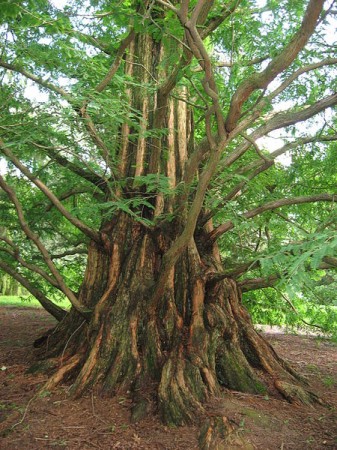
Metasequoia was thought to be extinct until a living specimen was found in China in the 1940s, it has since taken off in the landscape trade though remains rare in the wild. I particularly like it, as well as bald cypress and other sequoias or redwoods, for the interesting trucks they develop over time, which makes them look so very old.
Any Dinosaur garden should include one or some of these trees, you can feel free to sub in from the list of relatives above, and cedars and larches also make interesting counterpoints (and are smaller trees generally). Both the cedars and larches also come in interesting weeping forms that can be twisted and trained into evocative shapes that lend well to this style of garden.
Ginkgo
Gingko biloba is also often called a living fossil. This tree is famous of course as a herbal supplement purported to aid memory and concentration, but it is also anciently old species, relatively unchanged from fossils 270 million years old. It is also related to no other modern tree or plant, it is a true unique specimen, and yes, dinosaurs ate it.
It is speculated that the tree would be fully extinct were it not preserved in cultivated by Chinese monks for over a thousand years, the stability of the old Chinese dynasties has provided us modern gardeners a real treat.
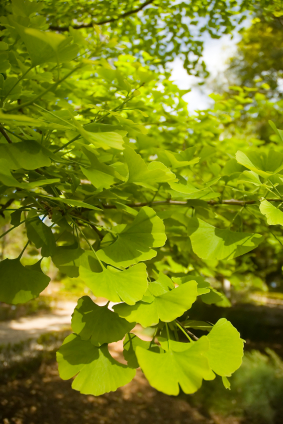
The trees can live for thousands of years, grow to over a hundred feet, have interesting unique trunks and leaves, tolerate pollution and compacted soil and all told make excellent urban shade trees. It is hardy in USDA zones 3-8, which covers more or less all temperate regions. As such you can grow it practically anywhere that isn’t Northern Alberta or Southern Florida.
Gingko trees are either male or female, and you need one of each sex to get usable seeds, which are nuts, though the trees do not flower, which I find interesting, essentially it is a tree with a fruit, but no flower. Instead the male produces a pollen cone and the female just produces ovules at the end of a stalk. The inner portion of the nuts are edible and are used in Asian cuisine, the outer portion has a horrible smell (and so many people plant exclusively male plants, to avoid the stinking nuts).
Cycads
Gingko does not have any living relatives, but the closest plant relative, if you had to name one, would be the cycad. Cycads, like Gingko and Ferns (below) have motile sperm (aka they can swim), a unique characteristic in the plant kingdom, perhaps a trait carried from a common ancestor plants and animals share from the dawn of time. I find that interesting anyways.
Cycads are commonly known as sago palms usually. There is a true sago palm, but what most people call a sago palm is actually a cycad. While they resemble palms of today and so get confused with them, they’re a much older species, 280 million years old to be exact.
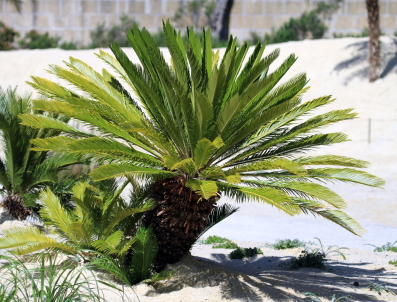
Cycads grow like palms, without branches, with the long pinnate (feather-like) leaves growing directly out from the trunk in like a rosette, though they’re typically shorter than palm trees. They grow slowly, and live a very very long time. Seeds can be poisonous, so watch out for those.
They are typically thought of as tropical plants, and they are, but there are some cultivars with marked hardiness, especially if you can achieve a microclimate somewhere in your yard. If you live in zone 7 you can at least experiment with owning a cycad, and if you live in zone 6 and can push it with a microclimate or provide some winter protection you might do well. Even if the leaves get zapped they usually will grow back.
Cycads in my opinion are one of the plants that really bring home the prehistoric aesthetic, especially if you can pair them with some conifers like metasequoia that I mentioned above. The combination of a plant style most commonly associated with colder areas, with a “palm” most commonly associated with the tropics, really can make your garden look exotic.
Ferns
So we’ve talked trees, and then many cycads are small enough to be considered shrubs, but what about the rest, the low growing filler plants? Well, ferns are what you want. I’m sure we all know what ferns are, they’re the shade loving (usually) plants with fronds that reproduce with spores or underground runners (no seeds, no flowers). They’re 360 million years old, though species you might currently plant date only to the cretaceous.
So if you have a lot of shade from your metasequoia and gingko trees, plant ferns underneath to complete the effect, a variety of ferns ideally, mix it up to make it look natural.
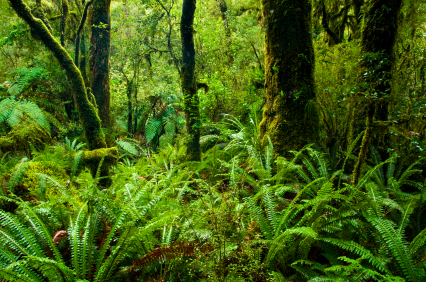
Most ferns also start off as a fiddlehead in early Spring, meaning the little green shoot comes out of the soil and resembles the top of a fiddle with the fronds all curled up. This part is edible like asparagus. You harvest the head at this stage, cook it, and eat it. It is highly seasonal though, for obvious reasons, once the fronds unfurl it is no longer a fiddlehead. The best for eating are ostrich ferns, but you can also eat lady ferns or bracken ferns (the one most commonly found in the wild in forests). All ferns need to be cooked prior to eating though to destroy a mild toxin they otherwise have. They were an important food for native peoples and are making a bit of a comeback on the farmer’s market scene now. I love it when we can eat portions of an otherwise ornamental garden.
Paw Paws
The one plant I will mention that is an angiosperm, that flowers, is the Paw Paw Asimina triloba. I do not know how old the species is, but it is quite old. It evolved before bees existed, and so has putrid flowers. You may have heard of the corpse flower, a flower that stinks like a rotting corpse because it is pollinated by carrion flies? Same sort of deal (though less pungent, I personally cannot detect any scent on the ones I grow). The paw paw is pollinated by beetles or flies, and you absolutely require two different trees for successful pollination (and pollination is hard to achieve, you may need to do it by hand).
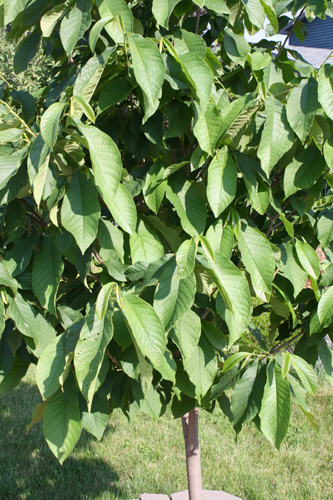
It is a relatively short relatively slow growing tree, native to North America, but what is most cool about it is that it looks like a fish out of water in that it has large simple ovoid leaves like you’d see in a rain forest, but it grows as far north as Canada. It definitely looks exotic, and the fruits, big green, somewhat oblong shaped, also look exotic, and they are delicious, if you can achieve successful pollination.
If not, it is a very attractive tree, with large elongated leaves unlike anything else you’ll see in a temperate climate anywhere in the world (as far as I know). It has no pest or disease issues either, and all told is remarkably well adapted. Because it doesn’t get very big it makes a great tree for a small yard. Which is good considering you need two for proper pollination.
Dinosaurs may not have eaten it, I’m not sure really, but when Dinosaurs roamed the Earth was warmer than it was now, and to provide that sort of prehistoric feeling much of it means creating a tropical feeling, and the paw paw looks tropical. Plus, it is delicious.
